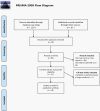The Natural History of Severe Acute Respiratory Syndrome Coronavirus 2-Related Multisystem Inflammatory Syndrome in Children: A Systematic Review
- PMID: 32924059
- PMCID: PMC7797745
- DOI: 10.1093/jpids/piaa112
The Natural History of Severe Acute Respiratory Syndrome Coronavirus 2-Related Multisystem Inflammatory Syndrome in Children: A Systematic Review
Abstract
Background: The clinical manifestations and natural history of severe acute respiratory syndrome coronavirus 2 (SARS-CoV-2)-related multisystem inflammatory syndrome in children (MIS-C) are poorly defined. Using a systematic review of individual cases and case series and collating elements of the clinical course, the objective of this study was to provide a detailed clinical description and natural history of MIS-C.
Methods: Case reports and series of MIS-C were recovered from repeated MEDLINE searches, a single EMBASE search, and table of contents reviews of major general medicine and pediatric journals performed between June 3 and July 23, 2020. Fever, evidence of inflammation, and evidence of organ dysfunction were required for inclusion.
Results: MEDLINE and EMBASE searches produced 129 articles, and 10 articles were identified from journal contents or article bibliographies; 16 reports describing 505 children with MIS-C comprise this review. Thirty-two children (14.7%) had negative results for SARS-CoV-2 by nucleic acid and/or antibody testing. The weighted median age was 9 years (6 months to 20 years). Clinical findings included fever (100%), gastrointestinal symptoms (88.0%), rash (59.2%), conjunctivitis (50.0%), cheilitis/ "strawberry tongue" (55.7%), or extremity edema/erythema (47.5%). Median serum C-reactive protein, ferritin, fibrinogen, and D-dimer concentrations were above the normal range. Intravenous gammaglobulin (78.1%) and methylprednisolone/prednisone (57.6%) were the most common therapeutic interventions; immunomodulation was used in 24.3% of cases. Myocardial dysfunction requiring ionotropic support (57.4%) plus extracorporeal membrane oxygenation (5.3%), respiratory distress requiring mechanical ventilation (26.1%), and acute kidney injury (11.9%) were the major complications; anticoagulation was used commonly (54.4%), but thrombotic events occurred rarely (3.5%). Seven (1.4%) children died.
Conclusions: MIS-C following SARS-CoV-2 infection frequently presents with gastrointestinal complaints and/or rash; conjunctivitis, cheilitis, and/or extremity changes also occur frequently. Serious complications occur frequently and respond to aggressive supportive therapy.
Keywords: MIS-C; SARS-CoV-2; systematic review.
© The Author(s) 2020. Published by Oxford University Press on behalf of The Journal of the Pediatric Infectious Diseases Society. All rights reserved. For permissions, please e-mail: journals.permissions@oup.com.
Figures
References
Publication types
MeSH terms
Supplementary concepts
LinkOut - more resources
Full Text Sources
Medical
Research Materials
Miscellaneous


